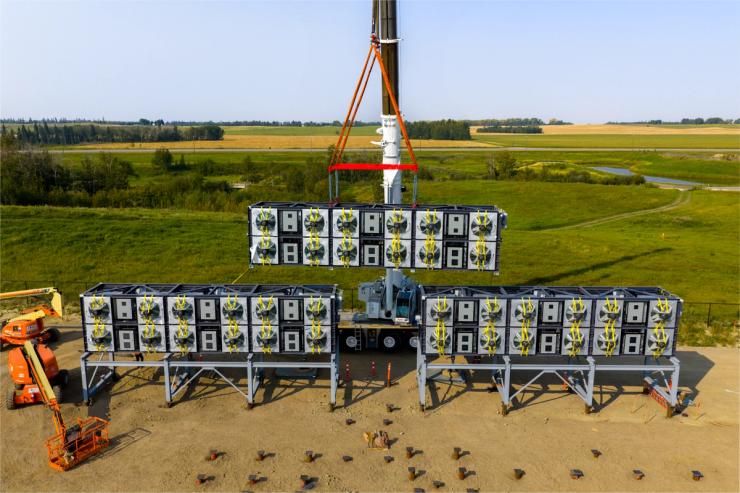The News
The Trump administration’s recent decision to rescind nearly $8 billion in funding for innovative energy projects could drive tech and fossil fuel companies to look outside the US for technologies both industries are keen to make use of.
The cuts affected more than 300 projects that received funding from the Department of Energy under the Biden administration, and overwhelmingly targeted projects located in majority-Democrat states.
One of the major casualties of the cuts was carbon removal: About $50 million in funding was rescinded for a range of projects tinkering with different methods for pulling CO2 from the atmosphere. That may come as little surprise, given President Donald Trump’s clear disinterest in mitigating climate change. But while the administration may be skeptical about the merits of such projects for their climate bona fides, carbon removal is nonetheless a growing global industry, driven in large part by interest from high-emissions industries like tech and oil. If the US no longer welcomes it, the carbon removal companies involved seem willing and able to look for a home elsewhere.
One company affected by the cuts was the California startup CarbonCapture Inc., which saw about $16 million withdrawn from three carbon removal projects it was involved in. CarbonCapture was an early beneficiary of the race by tech companies to buy carbon removal credits as a way of erasing their historic emissions, signing a deal with Microsoft back in 2023. But without the federal funding, those three projects — one each in California, Illinois, and Louisiana — are now “dead,” CEO Adrian Corless told Semafor. Even before the cuts, because of the Trump administration’s volatile approach to energy policy, Corless had already made a decision to relocate the company’s biggest-ever pilot plant from Arizona to Canada.
“What happened last week reinforced that we made the right decision and that for the foreseeable future, the US isn’t going to be where we focus our business,” he said. “The US developed itself into, by far, the leader in carbon removal over the past eight or so years. Now it would appear that [the Trump administration] is quite comfortable ceding that leadership role and just stepping away from it.”
In this article:
Tim’s view
The DOE funding cuts are the latest sign the administration is willing to put its animosity toward Democrats and anything that smacks of climate action above opportunities to lead in promising new industries.
Wind and solar energy were targeted early on, along with electric vehicles. The latest cuts go further, yanking support for low-carbon hydrogen, virtual power plants, and electric grid improvements in addition to carbon removal. The VPP and grid cuts will work against the administration’s goal of lowering retail power prices. And the hydrogen and carbon removal cuts will hurt nascent technologies that serve the long-term interests of the oil and gas industry. Capturing, transporting, and storing carbon are natural extensions of oil companies’ traditional engineering skillsets. Captured carbon can also be used to push more oil out of wells.
Tech companies including Amazon, Google, and Microsoft, meanwhile, have committed to buying millions of dollars in carbon removal credits as a cornerstone of their climate strategies, which haven’t changed despite the shifting political winds in the US. Carbon removal is also one of the few corners of cleantech where China has yet to dominate, Corless said, leaving an opening for other countries to seize. Altogether, carbon removal could evolve into a $1.2 trillion industry by 2050, according to a McKinsey forecast.
“What’s most at stake with these funding cuts is American competitiveness, and the economic benefits that come with being a leader in carbon management,” said Ben Rubin, executive director of the Carbon Business Council, an advocacy group. “An increasing number of companies are looking to other regions to deploy.”
Room for Disagreement
The administration didn’t offer a rationale for how it chose the specific projects to have their funding canceled, but it’s reasonable to be skeptical of how much of a climate benefit carbon removal will be able to make. Out of roughly 9 billion tons of CO2 that need to be removed annually from the atmosphere until 2050 to keep temperatures in line with the Paris Agreement, only about 2 billion are currently being removed, mostly by nature-based solutions like reforestation. Tech-heavy approaches like direct air capture, the method employed by CarbonCapture Inc., account for well below 1 million tons per year. One high-profile DAC project currently produces more CO2 than it captures.
And although Energy Secretary Chris Wright warned that more project cancellations are forthcoming, for now some of the carbon removal projects most closely linked to Big Oil, including projects being run by Chevron and Occidental Petroleum, haven’t faced the ax. And the 45Q tax credit for carbon capture was actually expanded, not eliminated, in Trump’s One Big Beautiful Bill Act.
Notable
- The Trump administration’s interference with wind projects is “very damaging,” the head of Shell’s US division said. “However far the pendulum swings one way, it’s likely that it’s going to swing just as far the other way,” Colette Hirstius, president of Shell USA, told the Financial Times.


